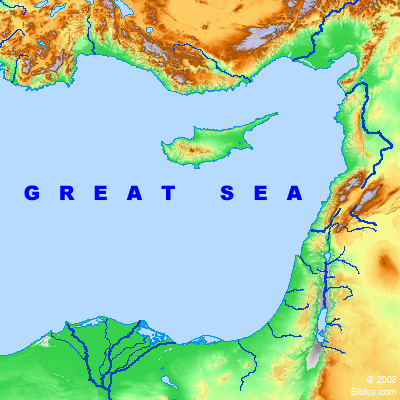Encyclopedia
SEA, THE GREAT(ha-yam ha-gadhol):
1. Names of the Sea:
This is the name given to the Mediterranean, which formed the western boundary of Palestine (Numbers 34:6 Joshua 15:12, 47 Ezekiel 47:19; Ezekiel 48:28). It is also called "the hinder sea" (Hebrew ha-yam ha-'aharon), i.e. the western sea (Deuteronomy 11:24; Deuteronomy 34:2 Joel 2:20 Zechariah 14:8), and "the sea of the Philis" (Exodus 23:31), which, of course, applies especially to the part washing the shore of Philistia, from Jaffa southward. Generally, when the word "sea" is used, and no other is definitely indicated, the Mediterranean is intended (Genesis 49:13 Numbers 13:29, etc.). It was the largest sheet of water with which the Hebrews had any acquaintance. Its gleaming mirror, stretching away to the sunset, could be seen from many an inland height.
2. Israel and the Sea:
It bulked large in the minds of the landsmen-for Israel produced few mariners-impressing itself upon their speech, so that "seaward" was the common term for "westward" (Exodus 26:22 Joshua 5:1, etc.). Its mystery and wonder, the raging of the storm, and the sound of "sorrow on the sea," borne to their upland ears, infected them with a strange dread of its wide waters, to which the seer of Patmos gave the last Scriptural expression in his vision of the new earth, where "the sea is no more" (Revelation 21:1).
3. The Coast Line:
Along the coast lay the tribal territories assigned to Asher, Zebulun, Manasseh, Dan and Judah. Many of the cities along the shore they failed to possess, however, and much of the land. The coast line offered little facility for the making of harbors. The one seaport of which in ancient times the Hebrews seem to have made much use was Joppa-the modern Jaffa (2 Chronicles 2:16, etc.). From this place, probably, argosies of Solomon turned their prows westward. Here, at least, "ships of Tarshish" were wont to set out upon their adventurous voyages (Jonah 1:3). The ships on this sea figure in the beautiful vision of Isaiah (60:8).
See ACCO; JOPPA.
4. The Sea in the New Testament:
The boy Jesus, from the heights above Nazareth, must often have looked on the waters of the great sea, as they broke in foam on the curving shore, from the roots of Carmel to the point at Acre. Once only in His journeyings, so far as we know, did He approach the sea, namely on His ever-memorable visit to the "borders of Tyre and Sidon" (Matthew 15:21 Mark 7:24). The sea, in all its moods, was well known to the great apostle of the Gentiles. The three shipwrecks, which he suffered (2 Corinthians 11:25), were doubtless due to the power of its angry billows over the frail craft of those old days.
See PAUL.
5. Debt of Palestine to the Sea:
The land owes much to the great sea. During the hot months of summer, a soft breeze from the water springs up at dawn, fanning all the seaward face of the Central Range. At sunset the chilled air slips down the slopes and the higher strata drift toward the uplands, charged with priceless moisture, giving rise to the refreshing dews which make the Palestinian morning so sweet.
See , further, MEDITERRANEAN SEA.
W. Ewing




